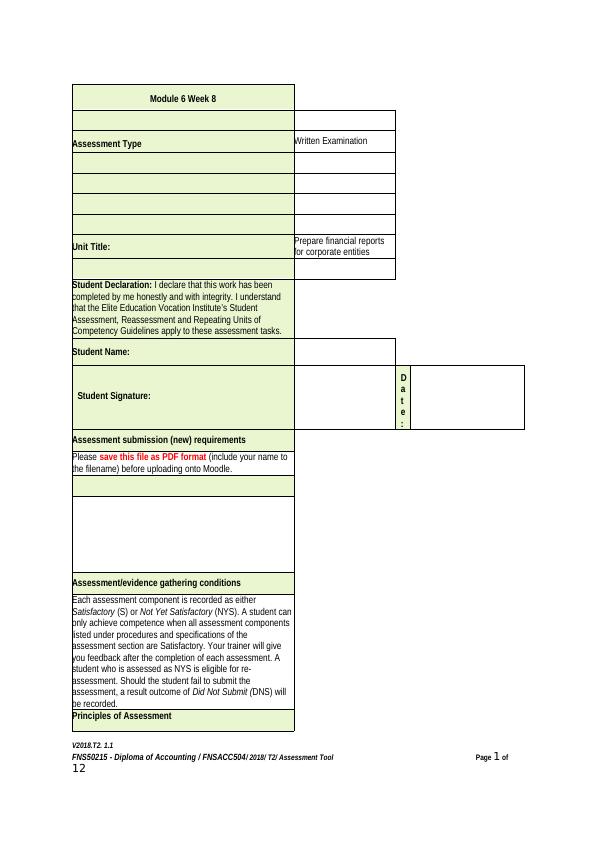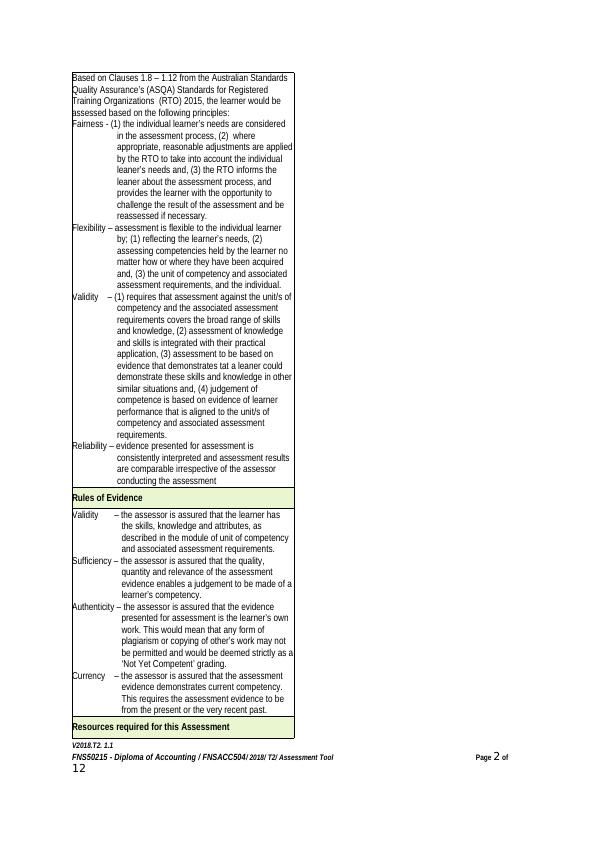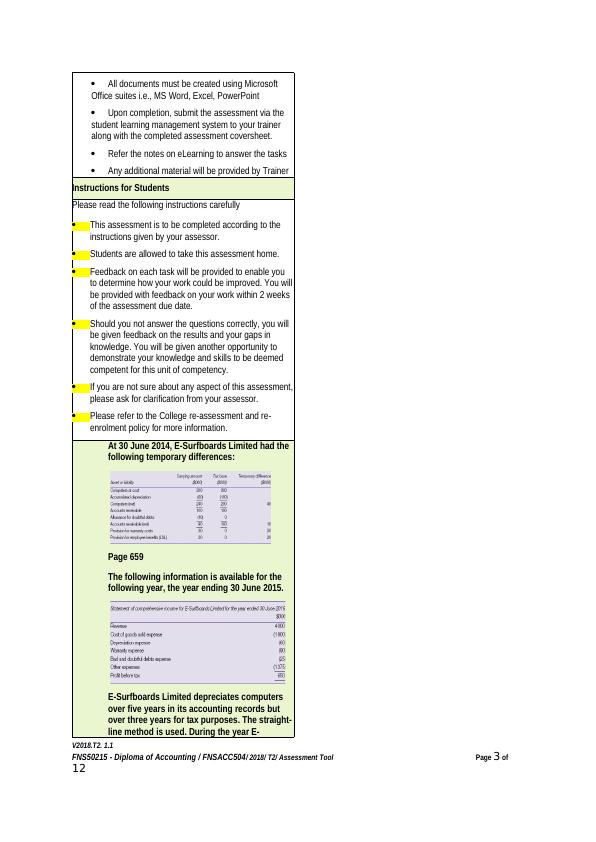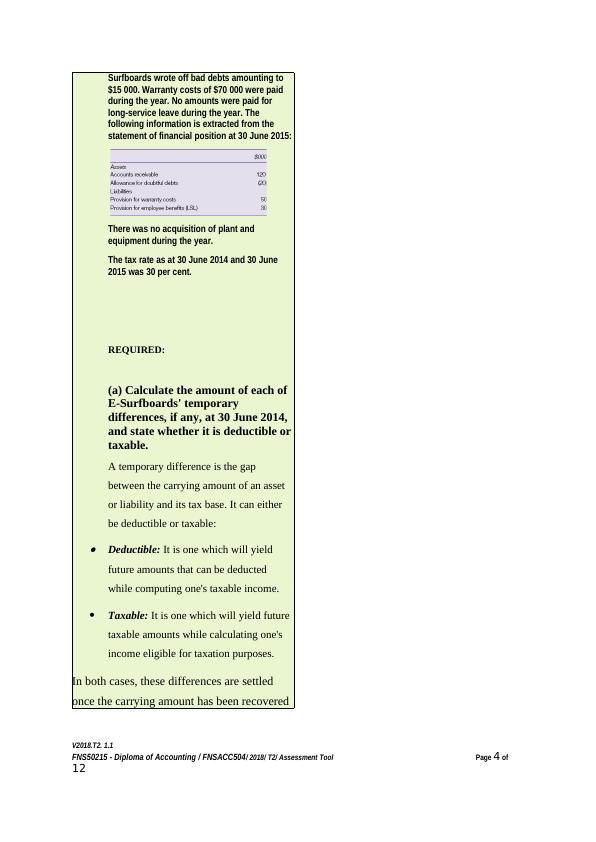Calculate E-Surfboards' taxable income for the year ended 30 June 2015
12 Pages2054 Words89 Views
Added on 2023-02-01
About This Document
This document provides instructions and calculations for determining E-Surfboards' taxable income for the year ended 30 June 2015. It includes information on temporary differences, deferred tax liability and asset, and journal entries for recording current tax and deferred tax.
Calculate E-Surfboards' taxable income for the year ended 30 June 2015
Added on 2023-02-01
ShareRelated Documents
Module 6 Week 8
Assessment Type Written Examination
Unit Title: Prepare financial reports
for corporate entities
Student Declaration: I declare that this work has been
completed by me honestly and with integrity. I understand
that the Elite Education Vocation Institute’s Student
Assessment, Reassessment and Repeating Units of
Competency Guidelines apply to these assessment tasks.
Student Name:
Student Signature:
D
a
t
e
:
Assessment submission (new) requirements
Please save this file as PDF format (include your name to
the filename) before uploading onto Moodle.
Assessment/evidence gathering conditions
Each assessment component is recorded as either
Satisfactory (S) or Not Yet Satisfactory (NYS). A student can
only achieve competence when all assessment components
listed under procedures and specifications of the
assessment section are Satisfactory. Your trainer will give
you feedback after the completion of each assessment. A
student who is assessed as NYS is eligible for re-
assessment. Should the student fail to submit the
assessment, a result outcome of Did Not Submit (DNS) will
be recorded.
Principles of Assessment
V2018.T2. 1.1
FNS50215 - Diploma of Accounting / FNSACC504/ 2018/ T2/ Assessment Tool Page 1 of
12
Assessment Type Written Examination
Unit Title: Prepare financial reports
for corporate entities
Student Declaration: I declare that this work has been
completed by me honestly and with integrity. I understand
that the Elite Education Vocation Institute’s Student
Assessment, Reassessment and Repeating Units of
Competency Guidelines apply to these assessment tasks.
Student Name:
Student Signature:
D
a
t
e
:
Assessment submission (new) requirements
Please save this file as PDF format (include your name to
the filename) before uploading onto Moodle.
Assessment/evidence gathering conditions
Each assessment component is recorded as either
Satisfactory (S) or Not Yet Satisfactory (NYS). A student can
only achieve competence when all assessment components
listed under procedures and specifications of the
assessment section are Satisfactory. Your trainer will give
you feedback after the completion of each assessment. A
student who is assessed as NYS is eligible for re-
assessment. Should the student fail to submit the
assessment, a result outcome of Did Not Submit (DNS) will
be recorded.
Principles of Assessment
V2018.T2. 1.1
FNS50215 - Diploma of Accounting / FNSACC504/ 2018/ T2/ Assessment Tool Page 1 of
12

Based on Clauses 1.8 – 1.12 from the Australian Standards
Quality Assurance’s (ASQA) Standards for Registered
Training Organizations (RTO) 2015, the learner would be
assessed based on the following principles:
Fairness - (1) the individual learner’s needs are considered
in the assessment process, (2) where
appropriate, reasonable adjustments are applied
by the RTO to take into account the individual
leaner’s needs and, (3) the RTO informs the
leaner about the assessment process, and
provides the learner with the opportunity to
challenge the result of the assessment and be
reassessed if necessary.
Flexibility – assessment is flexible to the individual learner
by; (1) reflecting the learner’s needs, (2)
assessing competencies held by the learner no
matter how or where they have been acquired
and, (3) the unit of competency and associated
assessment requirements, and the individual.
Validity – (1) requires that assessment against the unit/s of
competency and the associated assessment
requirements covers the broad range of skills
and knowledge, (2) assessment of knowledge
and skills is integrated with their practical
application, (3) assessment to be based on
evidence that demonstrates tat a leaner could
demonstrate these skills and knowledge in other
similar situations and, (4) judgement of
competence is based on evidence of learner
performance that is aligned to the unit/s of
competency and associated assessment
requirements.
Reliability – evidence presented for assessment is
consistently interpreted and assessment results
are comparable irrespective of the assessor
conducting the assessment
Rules of Evidence
Validity – the assessor is assured that the learner has
the skills, knowledge and attributes, as
described in the module of unit of competency
and associated assessment requirements.
Sufficiency – the assessor is assured that the quality,
quantity and relevance of the assessment
evidence enables a judgement to be made of a
learner’s competency.
Authenticity – the assessor is assured that the evidence
presented for assessment is the learner’s own
work. This would mean that any form of
plagiarism or copying of other’s work may not
be permitted and would be deemed strictly as a
‘Not Yet Competent’ grading.
Currency – the assessor is assured that the assessment
evidence demonstrates current competency.
This requires the assessment evidence to be
from the present or the very recent past.
Resources required for this Assessment
V2018.T2. 1.1
FNS50215 - Diploma of Accounting / FNSACC504/ 2018/ T2/ Assessment Tool Page 2 of
12
Quality Assurance’s (ASQA) Standards for Registered
Training Organizations (RTO) 2015, the learner would be
assessed based on the following principles:
Fairness - (1) the individual learner’s needs are considered
in the assessment process, (2) where
appropriate, reasonable adjustments are applied
by the RTO to take into account the individual
leaner’s needs and, (3) the RTO informs the
leaner about the assessment process, and
provides the learner with the opportunity to
challenge the result of the assessment and be
reassessed if necessary.
Flexibility – assessment is flexible to the individual learner
by; (1) reflecting the learner’s needs, (2)
assessing competencies held by the learner no
matter how or where they have been acquired
and, (3) the unit of competency and associated
assessment requirements, and the individual.
Validity – (1) requires that assessment against the unit/s of
competency and the associated assessment
requirements covers the broad range of skills
and knowledge, (2) assessment of knowledge
and skills is integrated with their practical
application, (3) assessment to be based on
evidence that demonstrates tat a leaner could
demonstrate these skills and knowledge in other
similar situations and, (4) judgement of
competence is based on evidence of learner
performance that is aligned to the unit/s of
competency and associated assessment
requirements.
Reliability – evidence presented for assessment is
consistently interpreted and assessment results
are comparable irrespective of the assessor
conducting the assessment
Rules of Evidence
Validity – the assessor is assured that the learner has
the skills, knowledge and attributes, as
described in the module of unit of competency
and associated assessment requirements.
Sufficiency – the assessor is assured that the quality,
quantity and relevance of the assessment
evidence enables a judgement to be made of a
learner’s competency.
Authenticity – the assessor is assured that the evidence
presented for assessment is the learner’s own
work. This would mean that any form of
plagiarism or copying of other’s work may not
be permitted and would be deemed strictly as a
‘Not Yet Competent’ grading.
Currency – the assessor is assured that the assessment
evidence demonstrates current competency.
This requires the assessment evidence to be
from the present or the very recent past.
Resources required for this Assessment
V2018.T2. 1.1
FNS50215 - Diploma of Accounting / FNSACC504/ 2018/ T2/ Assessment Tool Page 2 of
12

All documents must be created using Microsoft
Office suites i.e., MS Word, Excel, PowerPoint
Upon completion, submit the assessment via the
student learning management system to your trainer
along with the completed assessment coversheet.
Refer the notes on eLearning to answer the tasks
Any additional material will be provided by Trainer
Instructions for Students
Please read the following instructions carefully
This assessment is to be completed according to the
instructions given by your assessor.
Students are allowed to take this assessment home.
Feedback on each task will be provided to enable you
to determine how your work could be improved. You will
be provided with feedback on your work within 2 weeks
of the assessment due date.
Should you not answer the questions correctly, you will
be given feedback on the results and your gaps in
knowledge. You will be given another opportunity to
demonstrate your knowledge and skills to be deemed
competent for this unit of competency.
If you are not sure about any aspect of this assessment,
please ask for clarification from your assessor.
Please refer to the College re-assessment and re-
enrolment policy for more information.
At 30 June 2014, E-Surfboards Limited had the
following temporary differences:
Page 659
The following information is available for the
following year, the year ending 30 June 2015.
E-Surfboards Limited depreciates computers
over five years in its accounting records but
over three years for tax purposes. The straight-
line method is used. During the year E-
V2018.T2. 1.1
FNS50215 - Diploma of Accounting / FNSACC504/ 2018/ T2/ Assessment Tool Page 3 of
12
Office suites i.e., MS Word, Excel, PowerPoint
Upon completion, submit the assessment via the
student learning management system to your trainer
along with the completed assessment coversheet.
Refer the notes on eLearning to answer the tasks
Any additional material will be provided by Trainer
Instructions for Students
Please read the following instructions carefully
This assessment is to be completed according to the
instructions given by your assessor.
Students are allowed to take this assessment home.
Feedback on each task will be provided to enable you
to determine how your work could be improved. You will
be provided with feedback on your work within 2 weeks
of the assessment due date.
Should you not answer the questions correctly, you will
be given feedback on the results and your gaps in
knowledge. You will be given another opportunity to
demonstrate your knowledge and skills to be deemed
competent for this unit of competency.
If you are not sure about any aspect of this assessment,
please ask for clarification from your assessor.
Please refer to the College re-assessment and re-
enrolment policy for more information.
At 30 June 2014, E-Surfboards Limited had the
following temporary differences:
Page 659
The following information is available for the
following year, the year ending 30 June 2015.
E-Surfboards Limited depreciates computers
over five years in its accounting records but
over three years for tax purposes. The straight-
line method is used. During the year E-
V2018.T2. 1.1
FNS50215 - Diploma of Accounting / FNSACC504/ 2018/ T2/ Assessment Tool Page 3 of
12

Surfboards wrote off bad debts amounting to
$15 000. Warranty costs of $70 000 were paid
during the year. No amounts were paid for
long-service leave during the year. The
following information is extracted from the
statement of financial position at 30 June 2015:
There was no acquisition of plant and
equipment during the year.
The tax rate as at 30 June 2014 and 30 June
2015 was 30 per cent.
REQUIRED:
(a) Calculate the amount of each of
E-Surfboards' temporary
differences, if any, at 30 June 2014,
and state whether it is deductible or
taxable.
A temporary difference is the gap
between the carrying amount of an asset
or liability and its tax base. It can either
be deductible or taxable: Deductible: It is one which will yield
future amounts that can be deducted
while computing one's taxable income.
Taxable: It is one which will yield future
taxable amounts while calculating one's
income eligible for taxation purposes.
In both cases, these differences are settled
once the carrying amount has been recovered
V2018.T2. 1.1
FNS50215 - Diploma of Accounting / FNSACC504/ 2018/ T2/ Assessment Tool Page 4 of
12
$15 000. Warranty costs of $70 000 were paid
during the year. No amounts were paid for
long-service leave during the year. The
following information is extracted from the
statement of financial position at 30 June 2015:
There was no acquisition of plant and
equipment during the year.
The tax rate as at 30 June 2014 and 30 June
2015 was 30 per cent.
REQUIRED:
(a) Calculate the amount of each of
E-Surfboards' temporary
differences, if any, at 30 June 2014,
and state whether it is deductible or
taxable.
A temporary difference is the gap
between the carrying amount of an asset
or liability and its tax base. It can either
be deductible or taxable: Deductible: It is one which will yield
future amounts that can be deducted
while computing one's taxable income.
Taxable: It is one which will yield future
taxable amounts while calculating one's
income eligible for taxation purposes.
In both cases, these differences are settled
once the carrying amount has been recovered
V2018.T2. 1.1
FNS50215 - Diploma of Accounting / FNSACC504/ 2018/ T2/ Assessment Tool Page 4 of
12

End of preview
Want to access all the pages? Upload your documents or become a member.
Related Documents
BSBMKG501 Identify And Evaluate Marketing Opportunities Assignmentlg...
|18
|3344
|202
BSBINN501 Establish Systems that Supports Innovationlg...
|16
|3395
|226
Report on Establish and Adjust the Marketing Mixlg...
|14
|3239
|52
BSBMKG606: Manage International Marketing Assignmentlg...
|16
|2993
|283
Term and Year 2017 Assessment Cover Sheetlg...
|15
|2950
|440
Financial Reports for Corporate Entities Assignmentlg...
|9
|1816
|269
